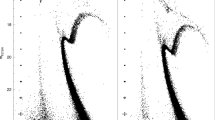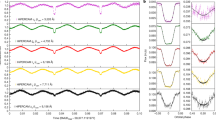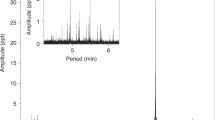Abstract
Cool subdwarfs are metal-poor low-mass stars that formed during the early stages of the evolution of our Galaxy. Because they are relatively rare in the vicinity of the Sun, we know of few cool subdwarfs in the solar neighbourhood, and none for which both the mass and the radius are accurately determined. This hampers our understanding of stars at the low-mass end of the main sequence. Here we report the discovery of SDSSJ235524.29+044855.7 as an eclipsing binary containing a cool subdwarf star, with a white dwarf companion. From the light curve and the radial-velocity curve of the binary we determine the mass and the radius of the cool subdwarf and we derive its effective temperature and luminosity by analysing its spectral energy distribution. Our results validate the theoretical relations between mass, radius, effective temperature and luminosity for low-mass, low-metallicity stars.
This is a preview of subscription content, access via your institution
Access options
Access Nature and 54 other Nature Portfolio journals
Get Nature+, our best-value online-access subscription
$29.99 / 30 days
cancel any time
Subscribe to this journal
Receive 12 digital issues and online access to articles
$119.00 per year
only $9.92 per issue
Buy this article
- Purchase on Springer Link
- Instant access to full article PDF
Prices may be subject to local taxes which are calculated during checkout





Similar content being viewed by others
Data availability
This work was based on observations made with the Gran Telescopio Canarias (GTC), installed in the Spanish Observatorio del Roque de los Muchachos of the Instituto de Astrofísica de Canarias, on the island of La Palma (program GTC21-18B), and on observations made with ESO Telescopes at the La Silla Paranal Observatory under programme ID 2100.D-5022(A). This publication makes use of VOSA, developed under the Spanish Virtual Observatory project supported from the Spanish MINECO through grant AyA2017-84089. This work made use of data from the European Space Agency (ESA) mission Gaia (https://www.cosmos.esa.int/gaia), processed by the Gaia Data Processing and Analysis Consortium (DPAC, https://www.cosmos.esa.int/web/gaia/dpac/consortium). Figures 1, 3 and 4 and Supplementary Figs. 1, 2 and 4 have associated raw data. The data that support the plots within this paper and other findings of this study are available from the corresponding author upon reasonable request.
Code availability
The spectral/decomposition routine and the radial-velocity fitting method used in this work are not publicly available. The light-curve fitting method is available at https://github.com/trmrsh/cpp-lcurve. MIDAS is available at https://www.eso.org/sci/software/esomidas//. VOSA is available at http://svo2.cab.inta-csic.es/theory/vosa/. iSpec is available at https://www.blancocuaresma.com/s/iSpec. The binary_c stellar evolution code is available at https://www.ast.cam.ac.uk/~rgi/binary_c.html. The X-Shooter reduction pipeline (version 2.9.3) is available at https://www.eso.org/sci/software/pipelines/xshooter/ and the dedicated HiPERCAM pipeline is available at https://github.com/HiPERCAM/hipercam.
References
Burrows, A., Hubbard, W. B., Saumon, D. & Lunine, J. I. An expanded set of brown dwarf and very low mass star models. Astrophys. J. 406, 158–171 (1993).
Morgan, W. W., Keenan, P. C. & Kellman, E. An Atlas of Stellar Spectra, with an Outline of Spectral Classification (University of Chicago Press, 1943).
Burgasser, A. J. et al. The first substellar subdwarf? Discovery of a metal-poor L dwarf with halo kinematics. Astrophys. J. 592, 1186–1192 (2003).
Digby, A. P., Hambly, N. C., Cooke, J. A., Reid, I. N. & Cannon, R. D. The subdwarf luminosity function. Mon. Not. R. Astron. Soc. 344, 583–601 (2003).
Rajpurohit, A. S. et al. High-resolution spectroscopic atlas of M subdwarfs. Effective temperature and metallicity. Astron. Astrophys. 564, A90 (2014).
Lépine, S., Rich, R. M. & Shara, M. M. Revised metallicity classes for low-mass stars: dwarfs (dM), subdwarfs (sdM), extreme subdwarfs (esdM), and ultrasubdwarfs (usdM). Astrophys. J. 669, 1235–1247 (2007).
Woolf, V. M., Lépine, S. & Wallerstein, G. Calibrating M-dwarf metallicities using molecular indices: extension to low-metallicity stars. Publ. Astron. Soc. Pac. 121, 117 (2009).
Gizis, J. E. M-subdwarfs: spectroscopic classification and the metallicity scale. Astron. J. 113, 806–822 (1997).
Stoughton, C. et al. Sloan Digital Sky Survey: early data release. Astron. J. 123, 485–548 (2002).
Cui, X.-Q. et al. The large sky area multi-object fiber spectroscopic telescope (LAMOST). Res. Astron. Astrophys. 12, 1197–1242 (2012).
Savcheva, A. S., West, A. A. & Bochanski, J. J. A new sample of cool subdwarfs from SDSS: properties and kinematics. Astrophys. J. 794, 145 (2014).
Bai, Y. et al. Nearby M subdwarfs from LAMOST data release 2. Res. Astron. Astrophys. 16, 107 (2016).
Kesseli, A. Y. et al. Radii of 88 M subdwarfs and updated radius relations for low-metallicity M dwarf stars. Preprint at https://arxiv.org/abs/1810.07702 (2018).
Jao, W.-C., Nelan, E. P., Henry, T. J., Franz, O. G. & Wasserman, L. H. Cool subdwarf investigations. III. Dynamical masses of low-metallicity subdwarfs. Astron. J. 152, 153 (2016).
Kepler, S. O. et al. New white dwarf stars in the Sloan Digital Sky Survey data release 10. Mon. Not. R. Astron. Soc. 446, 4078–4087 (2015).
Rebassa-Mansergas, A. et al. The SDSS spectroscopic catalogue of white dwarf-main-sequence binaries: new identifications from DR 9–12. Mon. Not. R. Astron. Soc. 458, 3808–3819 (2016).
Ren, J.-J. et al. White dwarf-main sequence binaries from LAMOST: the DR5 catalogue. Mon. Not. R. Astron. Soc. 477, 4641–4654 (2018).
Parsons, S. G. et al. Testing the white dwarf mass-radius relationship with eclipsing binaries. Mon. Not. R. Astron. Soc. 470, 4473–4492 (2017).
Parsons, S. G. et al. The scatter of the M dwarf mass−radius relationship. Mon. Not. R. Astron. Soc. 481, 1083–1096 (2018).
Drake, A. J. et al. First results from the Catalina Real-time Transient Survey. Astrophys. J. 696, 870–884 (2009).
Dhillon, V. et al. First light with HiPERCAM on the GTC. Proc. SPIE 10702, 107020L (2018).
Rebassa-Mansergas, A., Gänsicke, B. T., Rodrguez-Gil, P., Schreiber, M. R. & Koester, D. Post-common-envelope binaries from SDSS. I. 101 white dwarf main-sequence binaries with multiple Sloan Digital Sky Survey spectroscopy. Mon. Not. R. Astron. Soc. 382, 1377–1393 (2007).
Rajpurohit, A. S. et al. Spectral energy distribution of M-subdwarfs: a study of their atmospheric properties. Astron. Astrophys. 596, A33 (2016).
Koester, D. White dwarf spectra and atmosphere models. Mem. Soc. Astron. Ital. 81, 921–931 (2010).
Althaus, L. G., De Gerónimo, F., Córsico, A., Torres, S. & Garca-Berro, E. The evolution of white dwarfs resulting from helium-enhanced, low-metallicity progenitor stars. Astron. Astrophys. 597, A67 (2017).
Copperwheat, C. M. et al. Physical properties of IP Pegasi: an eclipsing dwarf nova with an unusually cool white dwarf. Mon. Not. R. Astron. Soc. 402, 1824–1840 (2010).
Bayo, A. et al. VOSA: virtual observatory SED analyzer. An application to the Collinder 69 open cluster. Astron. Astrophys. 492, 277–287 (2008).
Pickles, A. J. A stellar spectral flux library: 1150–25000 Å. Publ. Astron. Soc. Pac. 110, 863–878 (1998).
Hewett, P. C., Warren, S. J., Leggett, S. K. & Hodgkin, S. T. The UKIRT infrared Deep Sky Survey ZY JHK photometric system: passbands and synthetic colours. Mon. Not. R. Astron. Soc. 367, 454–468 (2006).
Wright, E. L. et al. The Wide-field Infrared Survey Explorer (WISE): mission description and initial on-orbit performance. Astron. J. 140, 1868–1881 (2010).
Skrutskie, M. F. et al. The Two Micron All Sky Survey (2MASS). Astron. J. 131, 1163–1183 (2006).
Cross, N. J. G. et al. The VISTA science archive. Astron. Astrophys. 548, A119 (2012).
Lépine, S. et al. A spectroscopic catalog of the brightest (J < 9) M dwarfs in the Northern sky. Astron. J. 145, 102 (2013).
Mann, A. W., Brewer, J. M., Gaidos, E., Lépine, S. & Hilton, E. J. Prospecting in late-type dwarfs: a calibration of infrared and visible spectroscopic metallicities of late K and M dwarfs spanning 1.5 dex. Astron. J. 145, 52 (2013).
Blanco-Cuaresma, S., Soubiran, C., Heiter, U. & Jofré, P. Determining stellar atmospheric parameters and chemical abundances of FGK stars with iSpec. Astron. Astrophys. 569, A111 (2014).
Iben, I. Jr. & Livio, M. Common envelopes in binary star evolution. Publ. Astron. Soc. Pac. 105, 1373–1406 (1993).
Hurley, J. R., Tout, C. A. & Pols, O. R. Evolution of binary stars and the effect of tides on binary populations. Mon. Not. R. Astron. Soc. 329, 897–928 (2002).
Catalán, S., Isern, J., Garca-Berro, E. & Ribas, I. The initial-final mass relationship of white dwarfs revisited: effect on the luminosity function and mass distribution. Mon. Not. R. Astron. Soc. 387, 1693–1706 (2008).
Cummings, J. D., Kalirai, J. S., Tremblay, P.-E., Ramirez-Ruiz, E. & Choi, J. The white dwarf initial-final mass relation for progenitor stars from 0.85 to 7.5 M⊙. Astrophys. J. 866, 21 (2018).
Izzard, R. G., Tout, C. A., Karakas, A. I. & Pols, O. R. A new synthetic model for asymptotic giant branch stars. Mon. Not. R. Astron. Soc. 350, 407–426 (2004).
Izzard, R. G. et al. Binary stars in the Galactic thick disc. Mon. Not. R. Astron. Soc. 473, 2984–2999 (2018).
Dotter, A. et al. The dartmouth stellar evolution database. Astrophys. J. 178, 89–101 (2008).
Feiden, G. A., Chaboyer, B. & Dotter, A. Accurate low-mass stellar models of KOI-126. Astrophys. J. 740, L25 (2011).
Baraffe, I., Chabrier, G., Allard, F. & Hauschildt, P. H. Evolutionary models for metal-poor low-mass stars. Lower main sequence of globular clusters and halo field stars. Astron. Astrophys. 327, 1054–1069 (1997).
Vernet, J. et al. X-shooter, the new wide band intermediate resolution spectrograph at the ESO Very Large Telescope. Astron. Astrophys. 536, A105 (2011).
Rechenberg, I. Evolutionsstrategie ‘94 (Froomann–Holzboog, 1994).
Rebassa-Mansergas, A. et al. The White Dwarf Binary Pathways survey. II. Radial velocities of 1453 FGK stars with white dwarf companions from LAMOST DR 4. Mon. Not. R. Astron. Soc. 472, 4193–4203 (2017).
Scargle, J. D. Studies in astronomical time series analysis. II. Statistical aspects of spectral analysis of unevenly spaced data. Astrophys. J. 263, 835–853 (1982).
Schwarzenberg-Czerny, A. Fast and statistically optimal period search in uneven sampled observations. Astrophys. J. 460, L107–L110 (1996).
Bloemen, S. et al. Kepler observations of the beaming binary KPD 1946+4340. Mon. Not. R. Astron. Soc. 410, 1787–1796 (2011).
Claret, A. Non-linear limb-darkening law for LTE models. VizieR Online Data Catalog 336, 31081 (2000).
Gianninas, A., Strickland, B. D., Kilic, M. & Bergeron, P. Limb-darkening coefficients for eclipsing white dwarfs. Astrophys. J. 766, 3 (2013).
Claret, A. & Bloemen, S. Gravity and limb-darkening coefficients for the Kepler, CoRoT, Spitzer, uvby, UBVRIJHK, and Sloan photometric systems. Astron. Astrophys. 529, A75 (2011).
Panei, J. A., Althaus, L. G., Chen, X. & Han, Z. Full evolution of low-mass white dwarfs with helium and oxygen cores. Mon. Not. R. Astron. Soc. 382, 779–792 (2007).
Press, W. H., Teukolsky, A. A., Vetterling, W. T. & Flannery, B. P. Numerical Recipes. The Art of Scientific Computing 3rd edn (Cambridge Univ. Press, 2007).
Allard, F., Homeier, D. & Freytag, B. Models of very-low-mass stars, brown dwarfs and exoplanets. Phil. Trans. R. Soc. Lond. Ser. A 370, 2765–2777 (2012).
Schlafly, E. F. & Finkbeiner, D. P. Measuring reddening with Sloan Digital Sky Survey stellar spectra and recalibrating SFD. Astrophys. J. 737, 103 (2011).
Bailer-Jones, C. A. L., Rybizki, J., Fouesneau, M., Mantelet, G. & Andrae, R. Estimating distance from parallaxes. IV. Distances to 1.33 billion stars in Gaia Data Release 2. Astron. J. 156, 58 (2018).
Gaia Collaboration et al. Gaia Data Release 2. Summary of the contents and survey properties. Astron. Astrophys. 616, A1 (2018).
Gustafsson, B. et al. A grid of MARCS model atmospheres for late-type stars. I. Methods and general properties. Astron. Astrophys. 486, 951–970 (2008).
Acknowledgements
This work was partially supported by the MINECO Ramón y Cajal programme RYJ-2016-20254 (to A.R.M.) and grant AYA2017-86274-P (to A.R.M. and S.T.) and by the AGAUR grant SGR-661/2017 (to A.R.M. and S.T.). S.G.P. acknowledges the support of the Leverhulme Trust. J.J.R. acknowledges support from the Joint Funds of the National Natural Sciences Foundation of China (grants U1531244 and U1831209), the NSFC grant 11833006 and the Young Researcher Grant of the National Astronomical Observatories, Chinese Academy of Sciences. HiPERCAM and V.S.D. are funded by the European Research Council under the European Union’s Seventh Framework Programme (FP/2007-2013) under ERC-2013-ADG grant agreement number 340040 (HiPERCAM). We thank F. Jimémez-Esteban for advice on the use of VOSA, A. Kesseli for sharing her ultra-subdwarf spectra and L. Althaus for discussions.
Author information
Authors and Affiliations
Contributions
All authors contributed to the work presented in this paper. A.R.M. performed the decomposition and fitting of the spectra, carried out the entire spectral analysis (except the one required by iSpec), conducted the VOSA analysis and led the writing of the manuscript. S.G.P. reduced all the spectroscopic and photometric data and carried out the light-curve analysis. V.S.D. and S.P.L. performed the GTC observations. J.J.R. conducted the iSpec analysis. V.S.D., S.P.L. and T.R.M. contributed to the development of HiPERCAM, a vital instrument for obtaining the results of this work. S.T. carried out the binary_c simulation and calculated the cooling age of the white dwarf. A.R.M., S.G.P. and J.J.R. discovered the system. All authors reviewed the manuscript.
Corresponding author
Ethics declarations
Competing interests
The authors declare no competing interests.
Additional information
Journal peer review information: Nature Astronomy thanks Sebastien Lepine and the other anonymous reviewer(s) for their contribution to the peer review of this work.
Publisher’s note: Springer Nature remains neutral with regard to jurisdictional claims in published maps and institutional affiliations.
Supplementary information
Supplementary Information
Supplementary Figs. 1–4, Supplementary Table 1.
Rights and permissions
About this article
Cite this article
Rebassa-Mansergas, A., Parsons, S.G., Dhillon, V.S. et al. Accurate mass and radius determinations of a cool subdwarf in an eclipsing binary. Nat Astron 3, 553–560 (2019). https://doi.org/10.1038/s41550-019-0746-7
Received:
Accepted:
Published:
Issue Date:
DOI: https://doi.org/10.1038/s41550-019-0746-7



